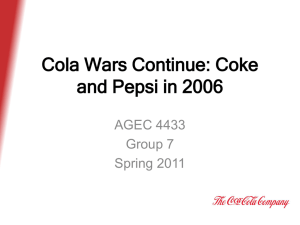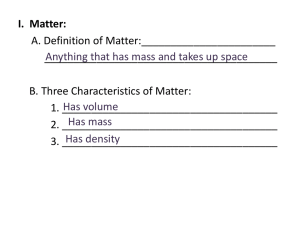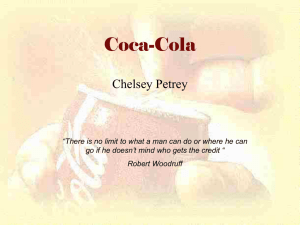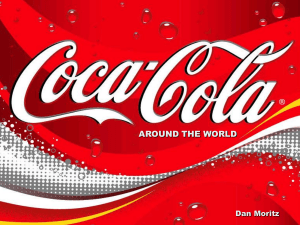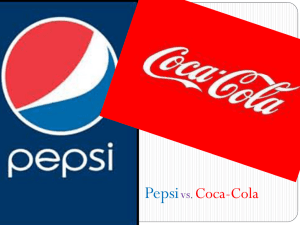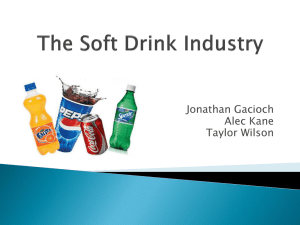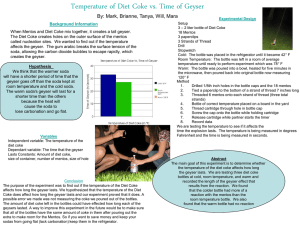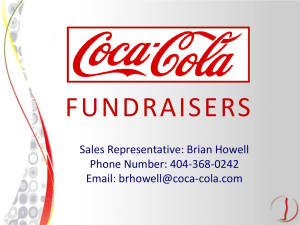SWOT_Coke
advertisement
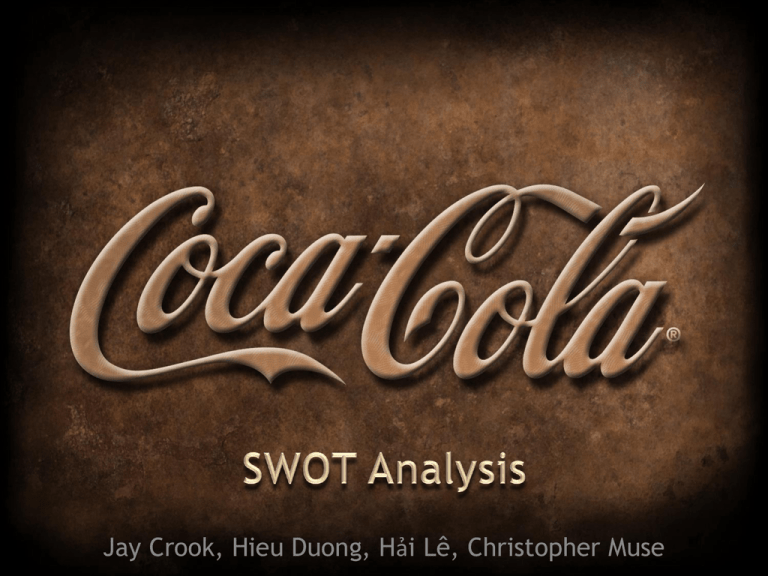
Jay Crook, Hieu Duong, Hải Lê, Christopher Muse Jay Crook 1885 - Pharmacist John Pemberton created a syrup formula that would become Coca-Cola. It was mixed with carbonated water at Jacob's Pharmacy in Atlanta, Georgia and was an instant success. The famous CocaCola script logo was created by Pemberton's bookkeeper, Frank Robinson, and used in newspaper advertisements. 1888 - Asa Candler bought the formula from Pemberton and started The Coca-Cola Company. Candler was a marketing wizard and with coupons, souvenir merchandising, posters and calendars made the Coca-Cola logo appear everywhere. He built syrup plants in Chicago, Boston, Los Angeles and Dallas. 1894 - Coca-Cola was first bottled in Vicksburg, Mississippi, but Candler ignored that possibility. 1899 - The bottling rights were sold to Benjamin Thomas, Joseph Whitehead and John Lupton for $1. That eventually became the Coca-Cola worldwide bottling system. 1916 - Due to imitation bottles of competitors, Coca-Cola bottlers agreed on a standard distinctive bottle shape. 1923 - Robert Woodruff became president of CocaCola. He was a marketing genius and made the company global. 1931 - During his leadership, Coca-Cola used its version of Santa Claus in advertising, becoming the American icon of Santa. 1935 - Coca-Cola first uses the coin-operated vending machine. 1964 - Introduces the lift-top can Starting with World War II, Coca-Cola started adding new brands. 1950s - Fanta 1961 - Sprite 1963 - TaB 1966 - Fresca 1979 - Mello Yello 1979 - Ramblin' Root Beer 1982 - Diet Coke Aquapure Aquarius Bacardi Mixers Bacardi Premium Mixers Barq's Barrilitos Beverly Bright And Early Caffeine free Barq's Caffeine free Coca-Cola Caffeine free Diet Coke Campbells Cascal cherry Coke Chippewa Citra Coca-Cola Coca-Cola Zero Cumberland Gap DANNON DASANI Delaware Punch Diet Barq's Diet cherry Coke Diet Coke Diet Coke with Lime Diet Fanta Diet Inca Kola Diet Mello Yello Diet NESTEA Diet Vanilla Coke Dr Pepper Evian Fanta Five Alive Flavor Rage Fresca Fruitopia FUZE Georgia glacéau smartwater glacéau vitaminwater glacéau vitaminwater zero Gold Peak H2OK Hi-C Honest Illy Inca Kola Java Monster Juan Valdez Krest Lift Master Chill Master Pour McCafe Mello Yello Mezzo Mix Minute Maid Minute Maid Enhanced Minute Maid Juices To Go Minute Maid Soft Drink Monster NESTEA NESTEA COOL Northern Neck NOS Odwalla Peace Pepe Rico Pibb POWERADE POWERADE LIGHT POWERADE PLAY Red Flash Simply Orange Smart Sokenbicha Southern Sun Sprite Sprite Remix Diet Sprite Sunfill TaB Vanilla Coke VAULT Vegitabeta Worx Energy Zico http://www.coca-colacompany.com/brands/all Oops! April 23, 1985 – New Coke July 11, 1985 – Coke Classic http://www.coca-colacompany.com/stories/coke-lore-new-coke http://www.interbrand.com/en/best-global-brands/2012/Best-Global-Brands-2012-Brand-View.aspx 1886 - Drink Coca-Cola 1904 - Delicious and Refreshing 1908 - Good Til the Last Drop 1929 - The Pause that Refreshes 1969 - It’s The Real Thing 1971 - I'd Like to Buy the World a Coke 1979 - Have a Coke and a Smile 1982 - Coke Is It 1986 - Catch the Wave 1990 - Can't Beat The Real Thing 1993 - Always Coca-Cola 2009 - Open Happiness 2011 - Life Begins Here Jay Crook http://finance.yahoo.com/q/co?s=COKE+Competitors High Pressure • The major competitors are Coca-Cola and Pepsi. Both have a wide range of beverage products. Coca-Cola has a long history that has created generations of loyal customers. Pepsi is trying to attract the younger generations with marketing • Other soda brands with unique flavors such as Dr. Pepper and Nehi Grape, compete with the market share • The top three companies hold more than 85 per cent of the market with Coca-Cola in the lead followed by PepsiCo and Dr. Pepper Snapple Carbonated Soft Drinks Shares for 2011 Low Pressure • There is a continuous line of new brands appearing in the market with often lower prices than Coke & Pepsi products • Existing bottlers have franchise agreements with major companies that prohibit them from taking on competing brands • Major competitors can instigate a price war • New entrants must supply a large population to overcome high fixed costs for warehouses, trucks, and labor, and economies of scale Medium to high pressure • Many soft drink products in the market. In a blind taste test, many people couldn’t tell the difference between Coca-Cola and Pepsi • More people are drinking bottled water, fruit juice, lemonade and tea instead of soda • Popularity of bottled water caused a drop in sales for carbonated drinks, with a market drop of 2.1% in 2009 • Energy drinks are growing fast in the beverage industry, but the market share is just 1% of the market. It may slow down due to calls for greater regulation and research • Other substitutes: tap water, milk, coffee, juices and alcoholic drinks Low pressure • The main ingredients for soft drinks include coloring, flavor, carbonated water, phosphoric acid, sweetener, additives and caffeine. There are many suppliers to choose from. • Any supplier would not want to lose a major customer. Low pressure • Major competitors price their soft drinks about the same. • Less popular beverages tend to have lower prices but flavor and quality may be lower. • Large retailers have bargaining power due to quantity, but that is suppressed because of consumer brand loyalty • Major buyers include food stores, convenience stores, fountain drink sellers and vending machine distributers • Restaurants have less bargaining power due to ordering a small volume demand • With less people drinking less soft drinks, the bargaining power of buyers could increase due to decreasing buyer demand Jay Crook Our Roadmap starts with our mission, which is enduring. It declares our purpose as a company and serves as the standard against which we weigh our actions and decisions. • To refresh the world... • To inspire moments of optimism and happiness... • To create value and make a difference. http://www.coca-colacompany.com/our-company/mission-vision-values Our vision serves as the framework for our Roadmap and guides every aspect of our business by describing what we need to accomplish in order to continue achieving sustainable, quality growth. • People: Be a great place to work where people are inspired to be the best they can be. • Portfolio: Bring to the world a portfolio of quality beverage brands that anticipate and satisfy people's desires and needs. • Partners: Nurture a winning network of customers and suppliers, together we create mutual, enduring value. • Planet: Be a responsible citizen that makes a difference by helping build and support sustainable communities. • Profit: Maximize long-term return to shareowners while being mindful of our overall responsibilities. • Productivity: Be a highly effective, lean and fast-moving organization. http://www.coca-colacompany.com/our-company/mission-vision-values Inspire creativity, passion, optimism and fun. http://www.coca-colacompany.com/our-company/mission-vision-values Hieu Duong 1. The popularity 2. Widely known for its quality and reputation 3. Customer loyalty 4. Brand value 5. Financial strength 6. Global business with strategy plan focus on sustainable development. 1. Popularity of the product: “Coca-Cola” is the second popular word all over the world, behind only "okay". No.1in sales worldwide Popular and enjoyed in over 200 countries around the world with more than 500 brands In America, two drinks leading position in popularity are 2 products of Coca-Cola: Coke and Diet Coke 2. Excellent quality drinks with a reputation built over 126 years of history Unique flavor than fresh The formula is kept the most secretly and is the most expensive formula worldwide Enjoying one culture, be part of history. 3. Customer loyalty Tradition passed from person to person, from generation to generation Ranked No.6 on the World’s 50 Most Admired Companies list The largest fan like on Facebook (reaching 55m people) 4. Brand value Coca Cola is the most expensive brand worldwide in 2012 ($77,839 million) Adapt and innovate to strengthen its brand value: o “Sharing Happiness” o “Move to the beat” 5. Financial strength Total net operating revenue is $46,542 million Total net income for share owners of Coca Cola Company is $8,752 million 6. Sustainable development Active healthy living Nutrition Product safely and quality Responsible marketing Women’s economic empowerment Charitable contribution Human and workplace rights Water stewardship Energy efficiency and climate protection Sustainable packaging and sustainable agriculture • Environmentally friendly, saves natural resources • Products comply with strict requirements on safety and nutrition • Charity work (382 water projects communities in 94 countries) Christopher Muse • Health Concerns While Coke is not “bad” for a person is it not a Healthy item • Nutrition Labels Coke has been labeling the number of calories on their products – – – – Coca-Cola 140 Calories per 12 ounces Cherry Coke 150 Calories per 12 ounces Diet Coke 0 Calories per 12 ounces Coke Zero 0 Calories per 12 ounces Hải Lê 1. Focusing on global expansion: Coca Cola’s plans for global expansion will enhance the market value of company’s stock. – China market – India market – Potential market – Africa 2. KO has many successful brands which can continue to be exploited and pursued, and providing the benefit for other products. 3. Buying out competition could increase the company’s revenue and market share. 4. KO’s brand recognition would provide the opportunity to leave its competitors behind. Christopher Muse http://finance.yahoo.com/q/co?s=COKE+Competitors PepsiCo is the Leading competitor • In 2011 PepsiCo – 28% of drink shares – 38% more revenue than coke due to other products such as Frito Lay, Quaker, Tropicana Increasing Health awareness among Americans • Soda Sales have dropped over the past 4 years – – – – 2011 2010 2009 2008 1% 0.5% 2.1% 3% Laws And regulations • New York City Sugary Drink Ban • Restaurants, fast food chains, and movie theaters are unable to sell sugary drinks that are more than 16 ounces • At the moment this law is limited to fountain drinks and does restrict bottled drinks sold at a grocery or convenient store • If this law can be passed, more strict laws could be passed as well Hải Lê • KO should increase investment in global expansion, especially Asian market and potential market Africa. • KO should take advantages from its current successful products in order to diverse product line and product depth. The dominant position in its current market could substantially provide many benefits for KO in launching new products. • KO should put more money on buy-out plan to turn its competitors’ profit to its own profit. • The final recommendation for KO is to recognizing its brand power and benefit itself in order to widen the gap between them and its competitors. Jay Crook, Hieu Duong, Hải Lê, Christopher Muse “Thanks for the SWOT that refreshes”
